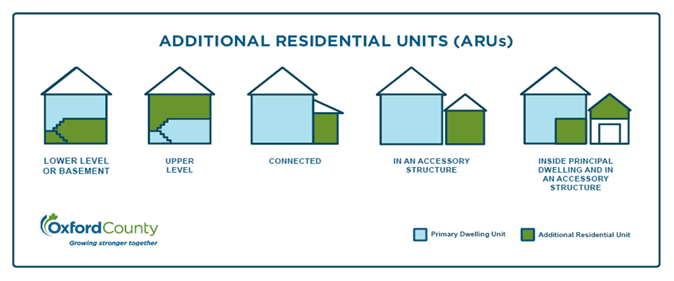Additional Residential Unit
Are you thinking about building an Additional Residential Unit (ARU) on your property? With the recent changes enacted under Bill 23, a maximum of two ARUs are permitted on each lot that has a single detached, semi-detached or townhouse dwelling.
Where two ARUs are located on a lot, at least one is required to be located within the main building. Only one ARU is permitted within a detached accessory structure.
While these options provide more flexibility for homeowners, there are important things to consider before before beginning your project.

Make a selection to learn more
An ARU is a residential dwelling unit that is completely self-contained and subordinate to the primary residential unit. The primary residential unit may be a single detached, semi-detached or townhouse dwelling. The ARU must be located within the same building and/or on the same lot as the primary residential unit.
All ARUs must include the following areas that are separate from the primary residential unit:
- separate entrance
- kitchen facilities
- washroom facilities
- living space
ARUs are permitted on properties zoned Low Density Residential (R1, R2, R3) and Entrepreneurial (EC). ARUs may be located within a single detached dwelling, semidetached dwelling, townhouse unit, or a detached accessory structure serving any of these permitted uses.
Not sure how your property is zoned? The County of Oxford's GLIMR mapping resource can help.
A maximum of two ARUs are permitted on each lot in addition to the principal dwelling. Where two ARUs are located on a lot, at least one is required to be located within the main building. Only one ARU is permitted within a detached accessory structure.
Bill 23 eases the zoning requirements associated with installing a secondary unit, but the Ontario Building Code requirements remain in place. ARUs must comply with the standard Code requirements for secondary suites in the main building, including: fire separations, minimum room sizes, minimum window sizes, entry and egress, servicing, etc.
Where the ARU is located in a detached accessory structure, the structure will need to be updated to meet all the necessary occupancy requirements for human habitation.
If the proposed ARU meets all the provisions of the ARU by-law, then typically only a building permit would be required.
If the proposed ARU is unable to meet the ARU by-law a minor variance may be required.
Properties that are adjacent to a ravine or a water course are likely within Long Point Regional Conservation Authority's (LPRCA) jurisdiction and are restricted areas unless a permit is obtained from their office.
Oxford County requires that the sanitary sewer and water systems be evaluated for every ARU. A F060 – ARU Sewage and Water System Capacity Confirmation form is required to be submitted with a building permit application.
ARUs inside the main building may be plumbed internally. Detached accessory structures may be serviced with a line connecting it to the main building. Only one roadside service is permitted per lot; a separate service to the ARU is not permitted.
For questions related to gas service, please contact Enbridge Gas.
For questions related to hydro, please contact Tillsonburg Hydro Inc (THI) at 519-688-3009 ext. 4828.

